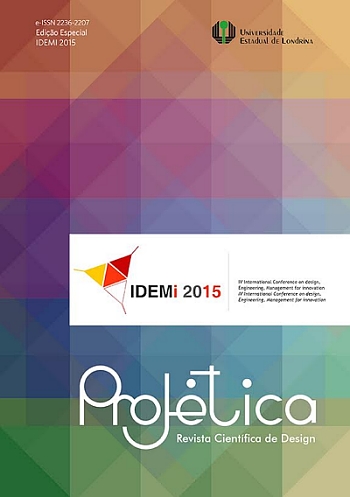Sustainable use of bamboo in Design – Case study of sousplat prototypes produced with bamboo waste
DOI:
https://doi.org/10.5433/2236-2207.2015v6n2p98Keywords:
Design Sustentabilidade, Inovação, BambuAbstract
Scientific studies emerge in various areas of knowledge in the search for sustainable solutions to the conventional production processes, considering the analysis of the products life cycle. Bamboo can be considered a real sustainable source because it integrates the three pillars of sustainability: environmental, social and economic. This raw material is regarded as one of the largest renewable biomass, as a substitute for wood. The aim of this study was to develop a project and carry out production of the physical prototype of a kitchen utensil, the Sousplat, meeting the demand for products (more) sustainable and the need for new products with added design for Viverde Agroecological Association of Settlement Aimorés Garden, Bauru, SP. The methodological processes made themselves from product definition to be developed, then there was a literature review about the bamboo and its applicability and issues surrounding this subject, since aspects related to sustainability materials to life cycle of products produced from bamboo and its waste. The development process of the concept of Sousplat project began in the analysis of similar products and materials applied to these, as has also analyzing the structure of bamboo. Observing their structural morphological characteristics, their training and their cell arrangement, established a correlation between the shape of these cells and conventional Sousplat, while you set up the use of bamboo residue boards (bamboo cluster) and rings obtained from waste bamboo culms in nature as the ideal raw material. Obtained prototypes and delivered to Viverde along with the projects, scientific work reached an additional achievement with the use of residual stalks of bamboo rings fresh and waste for the production of Sousplat, reaffirming Viverde Association in the context of sustainability, a trend global and innovative. Re-use of bamboo in the form of waste, attenuates and can solve the problem of waste accumulation, in the shed of Viverde Association, resulting from the production of other objects bamboo base.Downloads
References
BATTISTELLE, R. A. G.; VALARELLI, I. D.; SANTOS, M. F. N. Compósitos com resíduos de bambu, celulose e papel e Tetra Pak com aplicação em design de produtos. Revista Madeira e Arquitetura & Engenharia, v. 16, n. 6, p. 1-12, 2005.
CARVALHO, M. R. O.; VALARELLI, I. D. D.; VISNARDI, O. C. Avaliação do comportamento das chapas aglomeradas de bambu e Pinus em relação ao teor de umidade, absorção de água e inchamento em espessura”, In: CONGRESSO DE INICIAÇÃO CIENTÍFICA DA UNESP, São José do Rio Preto, 2006. Disponível em: http//prope.unesp.br/xxi_cic. Acesso em:22 de março de 2015.
COSTA, C. C.; FERNANDES, A. A. A sustentabilidade como caminho. In: CONFERÊNCIA INTERNACIONAL DE INTEGRAÇÃO DESIGN, ENGENHARIA E GESTÃO PARA A INOVAÇÃO,2., 2012, Florianópolis. Anais... Florianópolis: UFSC, 2012.
GHAVAMI, K.; MARINHO, A. B. Propriedades físicas e mecânicas do colmo inteiro do bambu da espécie Guadua angustifólia. Revista Brasileira de Engenharia Agrícola e Ambiental, v. 9, n.1, p. 107-114, 2005.
LOPES, Hidalgo O. Bamboo the gift of the gods. Bogotá: D'Vinni Ltda, 2003.
KRAVCHENKO, G. A.; FERREIRA, E. M.; PASQUALETTO, A. Utilização de Resíduos do Processamento de Chapas Laminadas de Bambu para Produção de Chapas Recompostas. INTERNATIONAL WORKSHOP | ADVANCES IN CLEANER PRODUCTION – ACADEMIC WORK, INTEGRATING CLEANER PRODUCTION INTO SUSTAINABILITY STRATEGIES, 4., 2013, São Paulo. Anais... São Paulo, 2013. p. 1-8
MAIA, P. B.; DIAS, N. A inspiração biológica no design de novos modelos de interação. In: CONFERÊNCIA INTERNACIONAL DE INTEGRAÇÃO DESIGN, ENGENHARIA E GESTÃO PARA A INOVAÇÃO, 2., 2012, Florianópolis. Anais... Florianópolis, 2012.
MANZINI, E.; VEZZOLI, C. O desenvolvimento de produtos sustentáveis: os requisitos ambientais dos produtos industriais. São Paulo: Edusp, 2002. p. 368.
MARINHO, N. P.; NASCIMENTO, E. M.; NISGOSKI, S.; VALARELLI, I. D. Some physical and mechanical properties of mediumdensity fiberboard made from giant bamboo. Materiais Research, São Carlos, v. 16, n. 6, p.1-6, 2013.
PAPANEK, V. Arquitetura e design: ecologia e ética. Lisboa: Edições 70, 1995. p. 256. 1995.
Parra, P. Design Simbólico: Cultura Projectual, Sistemas Biológicos e Sistemas Tecnológicos. 2007. Tese (Doutorado) - Universidade de Lisboa, Faculdade de Belas Artes, Lisboa, 2007.
PEREIRA, M. A. R.; RAMOS, B. P. F. Curvatura de Bambu Laminado Colado. In: CONGRESSO BRASILEIRO DE PESQUISA E DESENVOLVIMENTO EM DESIGN, 11., 2014, Gramado. Anais..., 2014. v . 1, p. 2044-2055.
STEIGLEDER, A. P.; OLIVEIRA, M. A. A, DUARTE, L.; RÜTHSGHILLING, E. A.; ROLDO, L. Interpretação e inspiração biônica da planta Salvínia Molesta no Design de produtos. CONGRESSO BRASILEIRO DE PESQUISA E DESENVOLVIMENTO EM DESIGN, 9., 2010, São Paulo. Anais... São Paulo, 2010
VALARELLI, I. D.; BATTISTELLE, R. A. G.; GONÇALVES, M. T. T.; SAMPAIO, R. M. A avaliação de propriedades física e mecânicas de chapas aglomeradas de partículas de colmo e folha caulinar de bambu Dendrocalamus giganteus. Revista Madeira e Arquitetura & Engenharia, v. 24, n. 10, p.63-75, 2009.
VALARELLI, I. D.; BATTISTELLE, R. A. G.; BUENO, M. A. P.; BEZERRA, B. S.; CAMPOS, C. I.; ALVES, M. C. S. Physical and mechanical properties of particleboard bamboo waste bonded with urea formaldehyde and castor oil based adhesive. Matéria, Rio de Janeiro, v. 19, n.1, p.1-7. 2014,
Downloads
Published
How to Cite
Issue
Section
License
Projética está licenciada sob a Creative Commons Attribution CC-BY 4.0 International. Os autores detém os direitos autorais e concedem à revista o direito de exclusividade de primeira publicação.
Os autores dos trabalhos aprovados autorizam Projética a, após a publicação, ceder seu conteúdo para reprodução em indexadores de conteúdo, bibliotecas virtuais e similares.
Os autores assumem que os textos submetidos à publicação são de sua criação original, responsabilizando-se inteiramente por seu conteúdo em caso de eventual impugnação por parte de terceiros. As opiniões emitidas pelos autores dos artigos são de sua exclusiva responsabilidade.
A revista se reserva o direito de efetuar, nos originais, alterações de ordem normativa, ortográfica e gramatical, com vistas a manter o padrão culto da língua e a credibilidade do veículo. Respeitará, no entanto, o estilo de escrever dos autores. Alterações, correções ou sugestões de ordem conceitual serão encaminhadas aos autores, quando necessário. Nesses casos, os artigos, depois de adequados, deverão ser submetidos a nova apreciação. As provas finais não serão encaminhadas aos autores.












